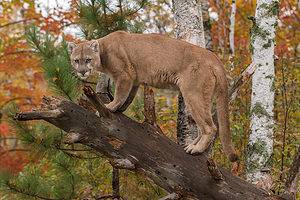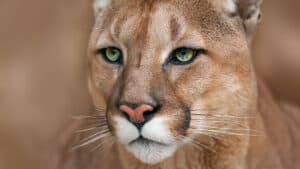The cougar is North America’s second largest species of the cat family. It can be found in British Columbia down through most of the western states in the United States. There is even a small population as far as Florida. But while the cougar is shy and hard to spot, the record for the largest cougar in Texas will show just how impressive cougars are.
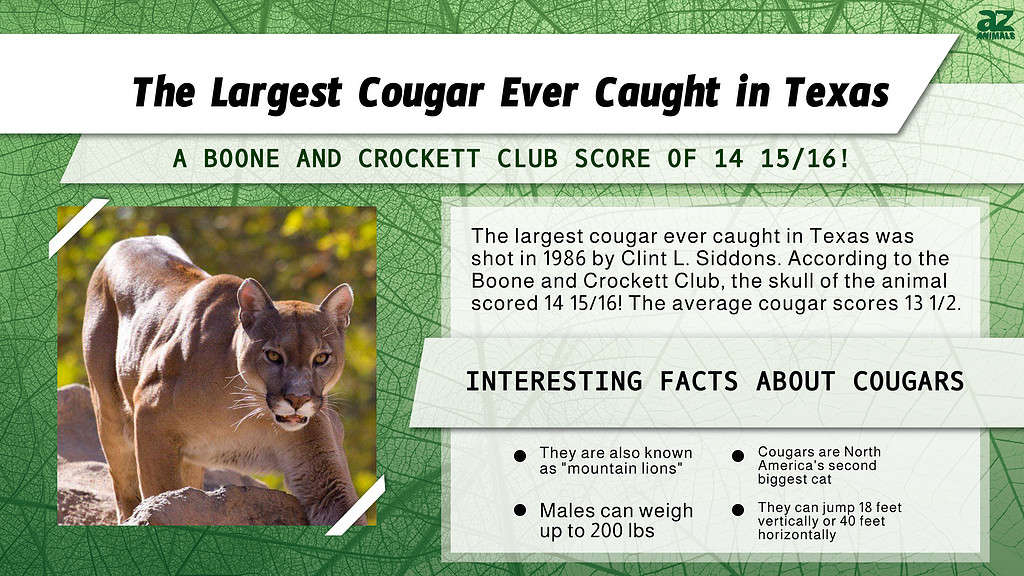
Characteristics
The cougar has many different names, such as “puma,” “panther,” “yellow cat,” and “mountain lion.” But whichever name you use, there is no doubt that the cougar is one of the most remarkable predators in Texas.
As adults, a male cougar, on average, measures 7.9 feet long, from head to tail, and a female averages 6.7 feet in length. A cougar’s tail accounts for a third of its length, measuring anywhere from 23.5 to 33.5 inches. Thanks to this long tail, a cougar can navigate rocky terrain and have exact balance while stalking prey.
A male cougar can weigh up to 200 pounds. That’s like the weight of an average washing machine! A female cougar can weigh up to 120 pounds. A cougar’s fur is short and can range from tan in color to yellow or dusty brown. In Latin, their name is Puma concolor, which means “of one color.” This fits cougars perfectly, save for their white underbellies.
Despite their size, a cougar can jump from a sitting position up to 18 feet vertically or 40 feet horizontally. This is very advantageous when it comes to hunting. Cougars mostly eat deer, wild sheep, birds, rabbits, and moose.
When cougars attack their prey, they target the neck. A cougar’s jaw is so strong that it can snap the neck of a deer. But more often, cougars will clamp down on the windpipe until their prey dies. This can be a fast way to take down larger prey, such as moose.
These ravenous cats can eat 20 pounds of meat at one time. For any leftovers, a cougar will hide and bury them, eating off the remains even ten days after the kill.
There are many more incredible cougar facts that you can read about too!
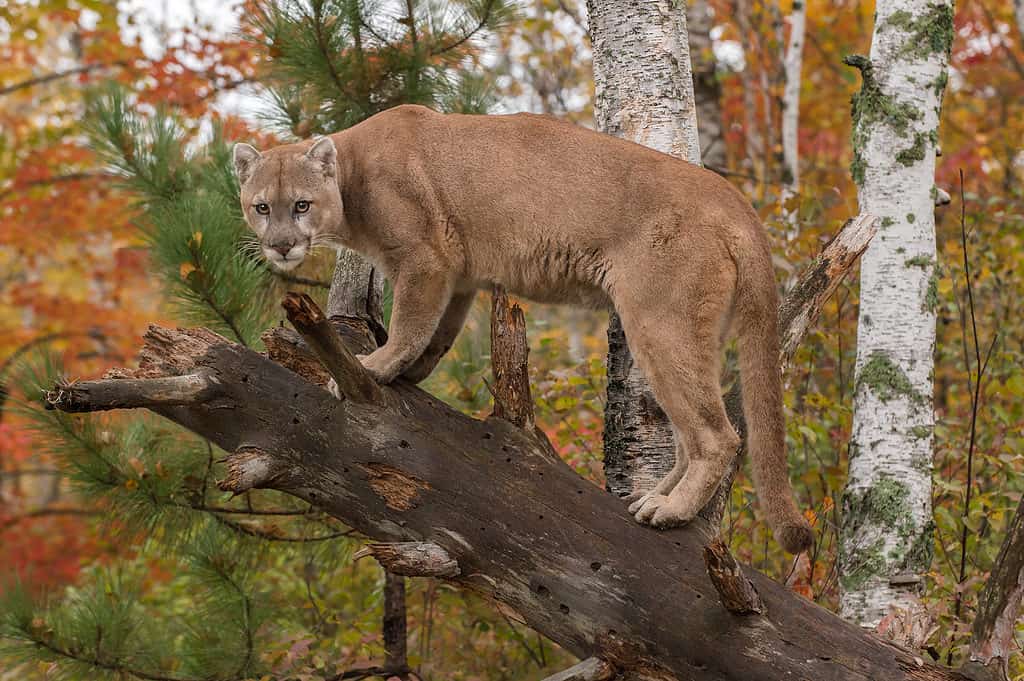
Clint L. Siddons holds the record for the largest cougar ever caught in Texas in 1986.
©Geoffrey Kuchera/Shutterstock.com
The Largest Cougar in Texas
The Boone and Crockett Club keeps a list of all recording-breaking game animals in each state, as well as in the world. They do this by “scoring” the head size. First, you measure the length of the skull and then add it to the width. The total number is then your “score.” Most Cougars average about a 13 1/2 score. But the largest cougar in Texas has a score of 14 15/16! Clint L. Siddons holds this Texas record for the cougar he shot in 1986.
Where Is Texas Located on a Map?
Cougars can be found in multiple states in the continental United States. So where is Texas located? Check out the map below to get a sense of one state where cougars roam free.
The Largest Cougar in the World
According to the Boone and Crockett Club’s record, it was killed in 1979 by Douglas E. Schuk in British Columbia. This cat weighed 276 pounds! That’s heavier than a Honda CRF250X dirt bike. The skull of the largest cougar on record scored 16 4/16 points! Schuk still holds that record today, over 40 years later. It is certainly a huge cat compared to the largest cougar in Texas.
Predators
The cougar has no predators in the wild. Sometimes, they will run into food conflicts with a pack of wolves or grizzly bears. Because a cougar is generally a solitary cat, these run-ins don’t work out for the cougar.
But, putting natural predators aside, humans are the most dangerous threat to cougars. Obviously, city developments and growing populations of humans shrink the natural habitat of a cougar. With that comes disruptions to a cougar’s food supply and mating. As developments advance, the cougar has no choice but to retreat.
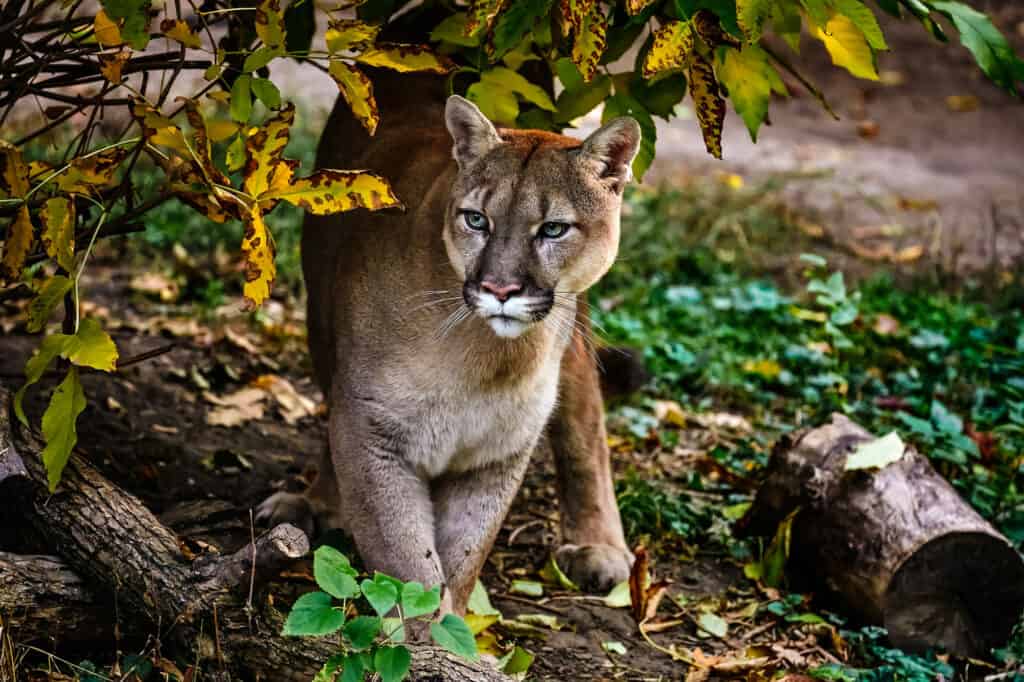
According to the Boone and Crockett Club’s record, the biggest cougar in the world was killed in 1979 by Douglas E. Schuk in British Columbia.
©Evgeniyqw/Shutterstock.com
Cougars and Humans
Because a cougar’s home is shrinking, it is having more encounters with humans. And so, it’s natural that people are scared of cougar attacks, but cougar encounters are much rarer than people realize. In fact, there have been only 20 fatalities since 1890. Cows, on the other hand, account for 22 human deaths a year on average.
But, what is more concerning for Texans is a cougar attacking livestock. Texas is number one in the beef industry, and cattle ranching is essential to the economy. A cougar can be more than a pest to some ranchers.
However, there isn’t very much research to demonstrate that hunting cougars is an effective prevention method. Instead, more agencies are teaching about non-lethal measures, such as fladry (temporary electric fencing with red nylon flags attached to the wire), livestock guardian dogs, or range riders. As we’ve said, cougars are shy cats, and these preventative measures will make cattle more trouble than they’re worth.
Conclusion
Even the largest cougar in Texas, while impressive, doesn’t mean that humans need to fear cougars. There are many ways in which we can co-exist with these cats. In fact, cougars help keep deer, elk, and moose populations down. Researchers found that in areas where the cougar has been killed off or driven out, the landscape becomes overrun by these vegetarians. They overgraze, which causes all kinds of problems like erosion and soil nutrient depletion. Overall, cougars are beneficial, and we can live in harmony with them in many ways.
The photo featured at the top of this post is © iStock.com/Nemyrivskyi Viacheslav
Thank you for reading! Have some feedback for us? Contact the AZ Animals editorial team.



